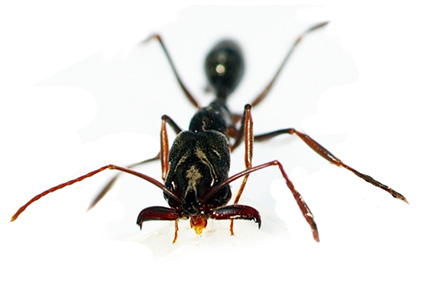Abstract
In this work, the results of a survey for species of Fluda Peckham & Peckham, 1892 in primary forest in five Bolivian forest ecoregions are reported. Fluda dauca sp. nov. is described from Southwest Amazon forest and F. thuruampara sp. nov. from Bolivian Yungas forest. Fluda perdita (Peckham & Peckham, 1892) is reported from Bolivia for the first time. Both new species exhibited polymorphic mimicry; dark females of both species resembled the turtle ant Cephalotes pusillus (Klug, 1824) and dark males of F. thuruampara sp. nov. the carpenter ant Camponotus sanctaefidei Dalla Torre, 1892. Orange males and females of F. dauca sp. nov. are likely mimics of Camponotus latangulus Roger, 1863. Males of Fluda may compensate lower mimetic accuracy by the broadened femora I, resembling an ant head in lateral view and ant mandibles when moving the face towards a potential threat. As in other Simonellini, the turnover of Fluda species between the South American superregions suggests that significant shifts in seasonality and related conditions are major factors triggering speciation in the tribe Simonellini.
References
Ceccarelli, F.S. (2013) Ant-mimicking spiders: strategies for living with social insects. Psyche: A Journal of Entomology, 2013, e839181. https://doi.org/10.1155/2013/839181
Cushing, P.E. (1997) Myrmecomorphy and myrmecophily in spiders: a review. Florida Entomologist, 80 (2), 165–193. https://doi.org/10.2307/3495552
Deeleman-Reinhold, C.L. (1993) A new spider genus from Thailand with a unique ant-mimicking device, with description of some other castianeirine spiders (Araneae: Corinnidae: Castianeirinae). Natural History Bulletin of the Siam Society, 40, 167–184.
Edwards, G.B. (2001) A synonym in the genus Fluda (Araneae: Salticidae). Insecta Mundi, 14, 252.
Galiano, M.E. (1971) Salticidae (Araneae) formiciformes. X. Revision del género Fluda Peckham, 1892. Physis. Revista de la Sociedad Argentina de Ciencias Naturales, 30, 573–599.
Galiano, M.E. (1994) Revision of the genus Pachomius (Araneae, Salticidae). Bulletin of the British Arachnological Society, 9, 214–220.
Hagopián, D., Aisenberg, A., Laborda, Á. & Simó, M. (2021) Morphological and behavioral traits associated with myrmecomorphy in Sarinda marcosi Piza, 1937 (Araneae: Salticidae: Sarindini). Journal of Arachnology, 48 (3), 262–271. https://doi.org/10.1636/JoA-S-19-069
Höfer, H. & Brescovit, A.D. (1994) Ergebnisse der Bolivien-Expedition des Staatlichen Museums für Naturkunde Karlsruhe: Spinnen (Araneae). Andrias, 13, 99–112.
Lim, M.L.M. & Li, D. (2004) Courtship and male-male agonistic behaviour of Cosmophasis umbratica Simon, an ornate jumping spider (Araneae: Salticidae) from Singapore. Raffles Bulletin of Zoology, 52 (2), 435–448.
Navarro, G. & Ferreira, W. (2007) Mapa de Sistemas Ecológicos de Bolivia, escala 1:250000. RUMBOL SRL-The Nature Conservancy (TNC), Bolivia. [Edición CD ROM]
Nelson, X.J. & Jackson, R.R. (2007) Complex display behaviour during the intraspecific interactions of myrmecomorphic jumping spiders (Araneae, Salticidae). Journal of Natural History, 41 (25), 1659–1678. https://doi.org/10.1080/00222930701450504
Nelson, X.J. & Jackson, R.R. (2012) How spiders practice aggressive and Batesian mimicry. Current Zoology, 58, 619–628. https://doi.org/10.1093/czoolo/58.4.620
Oliveira, P.S. (1988) Ant-mimicry in some Brazilian salticid and clubionid spiders (Araneae: Salticidae, Clubionidae) Biological Journal of the Linnean Society, 33, 1–15. https://doi.org/10.1111/j.1095-8312.1988.tb00443.x
Peckham, G.W. & Peckham, E.G. (1892) Ant-like spiders of the family Attidae. Occasional Papers of the Natural History Society of Wisconsin, 2 (1), 1–84.
Pekár, S. (2022) Two new ant-mimicking spiders (Araneae: Salticidae) from Costa Rica. European Journal of Taxonomy, 852, 31–42. https://doi.org/10.5852/ejt.2022.852.2005
Pekár, S., Martisová, M., Spalek Tóthová, A. & Haddad, C.R. (2022) Mimetic accuracy and co-evolution of mimetic traits in ant-mimicking species. iScience, 25, 105126. https://doi.org/10.1016/j.isci.2022.105126
Perger, R. & Rubio, G.D. (2020) Sympolymnia, a new genus of Neotropical ant-like spider, with description of two new species and indirect evidence for transformational mimicry (Araneae, Salticidae, Simonellini). Zoosystematics and Evolution, 96 (2), 781–795. https://doi.org/10.3897/zse.96.55210
Perger, R. & Rubio, G.D. (2022) A new genus of jumping spider from the Bolivian Yungas forest, a new country record for Erica eugenia Peckham & Peckham, 1892, and notes on turtle ant mimicry (Araneae: Salticidae: Simonellini). Arachnology, 19, 574–579. https://doi.org/10.13156/arac.2022.19.2.574
Perger, R., Rubio, G.D. & Haddad, C.R. (2021) On ant-like Synemosyna Hentz, 1846 spiders from Bolivia, with indirect evidence for polymorphic mimicry complexes (Araneae: Salticidae: Simonellini). European Journal of Taxonomy, 748 (1), 67–88. https://doi.org/10.5852/ejt.2021.748.1343
Rivas-Martínez, S., Navarro, G., Penas, A. & Costa, M. (2011) Biogeographic map of South America. A preliminary survey. International Journal of Geobotanical Research, 1, 21–40. https://doi.org/10.5616/ijgr110002
Soares, B.A.M. & Camargo, H.F. de A. (1948) Alguns novos salticidas do Brasil (Araneae, Salticidae). Revista Brasileira de Biologia, 8, 421–443.
Swenson, J.J., Young, B.E., Beck, S., Comer, P., Córdova, J.H., Dyson, J., Embert, D., Encarnación, F., Ferreira, W., Franke, I., Grossman, D., Hernandez, P., Herzog, S.K., Josse, C., Navarro, G., Pacheco, V., Stein, B.A., Timaná, M., Tovar, A., Tovar, C., Vargas, J. & Zambrana-Torrelio, C.M. (2012) Plant and animal endemism in the eastern Andean slope: challenges to conservation. BMC Ecology, 12, 1–18. https://doi.org/10.1186/1472-6785-12-1
World Spider Catalog (2022) Version 19.5. Natural History Museum Bern. Available from: http://wsc.nmbe.ch (accessed 1 August 2022)


